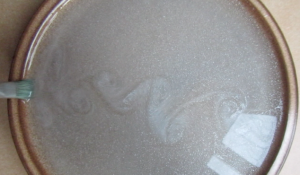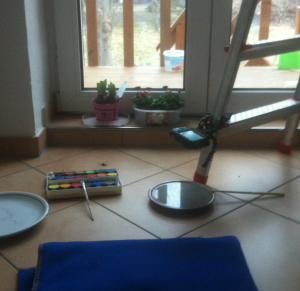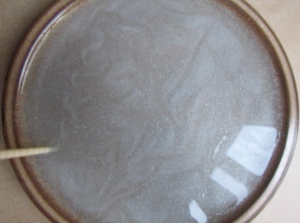
Vortex streets on a plate
You might think that three hours of canoe polo on a Saturday morning would be enough water for the day, but no. As when I did the experiment for the “eddies in a jar” post a while back, sometimes I just need to do some cool oceanography. So last Saturday, this is what I did:
 I took a plate, mixed some sugar, silvery water color, and water, pulled some stuff through the water and that was pretty much it. As a first order approximation, pulling an object through a stagnant water body is the same as the water body moving past a stationary object. And since it is usually pretty difficult to visualize flow around stationary objects (at least if you don’t want to pollute that little creek nor waste a lot of water). So this is really exciting.
I took a plate, mixed some sugar, silvery water color, and water, pulled some stuff through the water and that was pretty much it. As a first order approximation, pulling an object through a stagnant water body is the same as the water body moving past a stationary object. And since it is usually pretty difficult to visualize flow around stationary objects (at least if you don’t want to pollute that little creek nor waste a lot of water). So this is really exciting.
And for those of you who are always like “oh, I would love to, but I couldn’t possibly do this at home!”: This is what it looked like in my kitchen when I filmed the video above:
The plate I am filming is the one underneath the camera (I love my gorilla grippy). My water colors from back when I was in primary school, a paint brush, a chop stick, the plate I tried first that turned out to not have enough contrast with the silver paint, a blanket because the tiles are cold to sit on. Oh, and the flowers that I have been meaning to put into nice pots for a couple of days now. So – no big mystery here! Go try! And let me know how it went.

#KitchenOceanography - Adventures in Oceanography and Teaching says:
[…] experiments include density driven currents, overturning circulation, double-diffusive mixing, vortex streets, properties of freshwater and saltwater ice, effects of density on stratification, effects of […]
About the influence of viscosity: The Reynolds number – Elin Darelius & Team says:
[…] talking about here, since all seems so academic. And then I remembered that I did an experiment on vortex streets on a plate a while […]
About the influence of viscosity: The Reynolds number – Mirjam S. Glessmer says:
[…] as a good example for what I am talking about. And then I remembered that I did an experiment on vortex streets on a plate a while […]
Vortex street | says:
[…] showed you a vortex street on a plate formed by pulling a paint brush through sugary water as an example. Now today I want to show you […]
How can we use interactive flow simulations in teaching of hydrodynamics? | Adventures in Oceanography and Teaching says:
[…] Look at the Karman vortex street below (their movie, not mine!) – doesn’t it remind you of the vortex street on a plate? […]
Wave fields around objects in a channel | Adventures in Oceanography and Teaching says:
[…] ← Previous […]